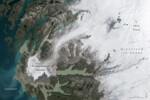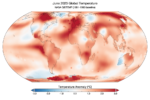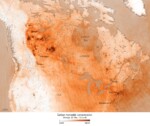
Monday, July 31st, 2023
More than halfway through the 2023 melting season, Greenland has seen a substantial transformation of its snow cover. Melting has been above average for much of the season, including on several days in June and July when melt was detected across 800,000 square kilometers (302,000 square miles)—up to 50 percent—of Greenland Ice Sheet’s surface, according

Monday, July 17th, 2023
June 2023 was the hottest June on record according to NASA’s global temperature analysis. Temperature anomalies reflect how June 2023 compared to the average June temperature from 1951-1980. GISTEMP, NASA’s global temperature analysis, is drawn from data collected by weather stations and Antarctic research stations as well as instruments mounted on ships and ocean buoys. NASA

Thursday, June 15th, 2023
As climate change increases the risk of wildfires across the globe, the spate of fires that hit Canada in May and June suggest that 2023 is on course to be the country’s worst fire season to date. These fires not only pose a serious threat to human life, wildlife the environment and property, they also

Tuesday, June 6th, 2023
When the dust that wafts off the Sahel and Sahara regions of Africa mixes with tropical clouds, it creates what’s known as a rainy “disturbance” in the eastern Atlantic. These disturbances are hurricanes in their youngest form, and as they travel across the ocean, they can either dissipate or grow into powerful storms. To study these

Monday, May 22nd, 2023
The most recent sea-level data from the U.S.-European satellite Sentinel-6 Michael Freilich indicates early signs of a developing El Niño across the equatorial Pacific Ocean. The data shows Kelvin waves, which are roughly 2 to 4 inches (5 to 10 centimeters) high at the ocean surface and hundreds of miles wide, moving from west to east along

Monday, May 8th, 2023
NOAA upgraded its Probabilistic Storm Surge (P-Surge) model—the primary model for predicting storm surge associated with high-impact weather like hurricanes and tropical storms—to version 3.0. This upgrade advances storm-surge modeling and forecasting for the contiguous United States (CONUS), Puerto Rico and the U.S. Virgin Islands, and comes just in time for the 2023 hurricane season beginning on

Monday, April 24th, 2023
Century-old sugar maples in Wisconsin. Five-hundred-year-old cedars in Oklahoma. Fifty-foot-wide oaks in Georgia. These trees grace our nation’s old-growth forests, and scientists say they hold unexplored mysteries from their roots to their rings. In an effort to steward these resources, on Earth Day 2022 the Biden Administration called upon the Department of Agriculture and the

Tuesday, April 11th, 2023
A NASA instrument to provide unprecedented resolution of monitoring major air pollutants—down to four square miles—lifted off on its way to geostationary orbit on April 7, 2023. The Tropospheric Emissions: Monitoring of Pollution (TEMPO) instrument will improve life on Earth by revolutionizing the way scientists observe air quality from space. “The TEMPO mission is about

Tuesday, March 28th, 2023
Despite an extreme drought in northwestern Iowa throughout summer 2022, the overall corn condition was better than in the previous two years. EOS Data Analytics explored the causes of these phenomena and explained how Iowa farmers tackle such prolonged dry conditions. During the last few decades, climate change had been bringing positive effects on crop

Saturday, March 11th, 2023
A NASA Earth-observing satellite has helped researchers track carbon dioxide emissions for more than 100 countries around the world. The pilot project offers a powerful new look at the carbon dioxide being emitted in these countries and how much of it is removed from the atmosphere by forests and other carbon-absorbing “sinks” within their borders. The
There are no upcoming events.
